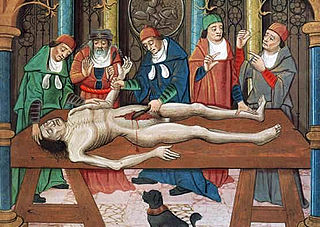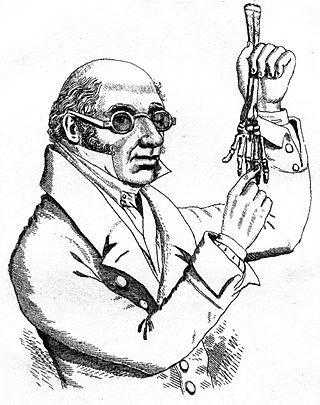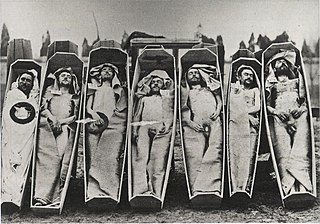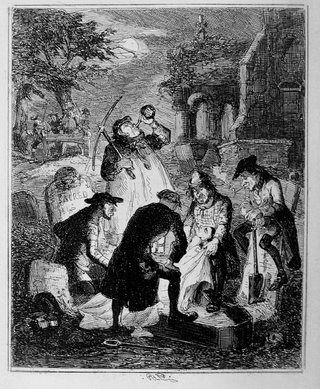Posthumous execution is the ritual or ceremonial mutilation of an already dead body as a punishment. It is typically performed to show that even in death, one cannot escape justice.

The history of anatomy extends from the earliest examinations of sacrificial victims to the sophisticated analyses of the body performed by modern anatomists and scientists. Written descriptions of human organs and parts can be traced back thousands of years to ancient Egyptian papyri, where attention to the body was necessitated by their highly elaborate burial practices.

The history of anatomy in the 19th century saw anatomists largely finalise and systematise the descriptive human anatomy of the previous century. The discipline also progressed to establish growing sources of knowledge in histology and developmental biology, not only of humans but also of animals.

Dissection is the dismembering of the body of a deceased animal or plant to study its anatomical structure. Autopsy is used in pathology and forensic medicine to determine the cause of death in humans. Less extensive dissection of plants and smaller animals preserved in a formaldehyde solution is typically carried out or demonstrated in biology and natural science classes in middle school and high school, while extensive dissections of cadavers of adults and children, both fresh and preserved are carried out by medical students in medical schools as a part of the teaching in subjects such as anatomy, pathology and forensic medicine. Consequently, dissection is typically conducted in a morgue or in an anatomy lab.

Body snatching is the illicit removal of corpses from graves, morgues, and other burial sites. Body snatching is distinct from the act of grave robbery as grave robbing does not explicitly involve the removal of the corpse, but rather theft from the burial site itself. The term 'body snatching' most commonly refers to the removal and sale of corpses primarily for the purpose of dissection or anatomy lectures in medical schools. The term was coined primarily in regard to cases in the United Kingdom and United States throughout the 17th, 18th, and 19th centuries. However, there have been cases of body snatching in many countries, with the first recorded case dating back to 1319 in Bologna, Italy.

Robert Knox was a Scottish anatomist and ethnologist best known for his involvement in the Burke and Hare murders. Born in Edinburgh, Scotland, Knox eventually partnered with anatomist and former teacher John Barclay and became a lecturer on anatomy in the city, where he introduced the theory of transcendental anatomy. However, Knox's incautious methods of obtaining cadavers for dissection before the passage of the Anatomy Act 1832 and disagreements with professional colleagues ruined his career in Scotland. Following these developments, he moved to London, though this did not revive his career.

Grave robbery, tomb robbing, or tomb raiding is the act of uncovering a grave, tomb or crypt to steal commodities. It is usually perpetrated to take and profit from valuable artefacts or personal property. A related act is body snatching, a term denoting the contested or unlawful taking of a body, which can be extended to the unlawful taking of organs alone.

Cholera riots are civil disturbances associated with an outbreak or epidemic of cholera.
"The Body Snatcher" is a short story by the Scottish author Robert Louis Stevenson (1850–1894). First published in The Pall Mall Gazette in December 1884, its characters were based on criminals in the employ of the surgeon Robert Knox (1791–1862) around the time of the notorious Burke and Hare murders in 1828.
Physicians for Human Rights (PHR) is a US-based not-for-profit human rights NGO that uses medicine and science to document and advocate against mass atrocities and severe human rights violations around the world. PHR headquarters are in New York City, with offices in Boston, Washington, D.C., as well as Nairobi. It was established in 1986 to use the unique skills and credibility of health professionals to advocate for persecuted health workers, prevent torture, document mass atrocities, and hold those who violate human rights accountable.

The Body Snatcher is a 1945 American horror film directed by Robert Wise, based on the 1884 short story of the same name by Robert Louis Stevenson. Philip MacDonald adapted the story for the screen, and producer Val Lewton, credited as "Carlos Keith", modified MacDonald's screenplay. The film stars Boris Karloff as John Gray, a cab driver who moonlights as a grave robber, and later murderer, to illegally supply Dr. MacFarlane with cadavers for his classes, and makes mention of Burke, Hare, and Dr. Knox, in reference to the West Port murders of 1828. Alongside Karloff and Daniell, the film's cast includes Russell Wade, Edith Atwater, and Bela Lugosi. It was the last film in which both Karloff and Lugosi appeared.
John Andre Lee is a retired English pathologist who was formerly clinical professor of pathology at Hull York Medical School and consultant histopathologist at Rotherham General Hospital, later becoming the Rotherham NHS Foundation Trust's Director of Cancer Services. Lee gained a BSc and a PhD in physiology at University College London, and then a medical degree subsequently specialising in pathology.

A cadaver or corpse is a dead human body. Cadavers are used by medical students, physicians and other scientists to study anatomy, identify disease sites, determine causes of death, and provide tissue to repair a defect in a living human being. Students in medical school study and dissect cadavers as a part of their education. Others who study cadavers include archaeologists and arts students. In addition, a cadaver may be used in the development and evaluation of surgical instruments.

Richard Bayley was a prominent New York City physician and the first chief health officer of the city. An expert in yellow fever, he helped discover its epidemiology, improved city sanitation, and authored the federal Quarantine Act of 1799. The 1788 Doctors' Riot was sparked by fears that his students were secretly removing corpses from graves in order to dissect them.
Night Doctors are bogeymen of African American folklore, resulting from some factual basis.
An anatomy murder is a murder committed in order to use all or part of the cadaver for medical research or teaching. It is not a medicine murder because the body parts are not believed to have any medicinal use in themselves. The motive for the murder is created by the demand for cadavers for dissection, and the opportunity to learn anatomy and physiology as a result of the dissection. Rumors concerning the prevalence of anatomy murders are associated with the rise in demand for cadavers in research and teaching produced by the Scientific Revolution. During the 19th century, the sensational serial murders associated with Burke and Hare and the London Burkers led to legislation which provided scientists and medical schools with legal ways of obtaining cadavers. Rumors persist that anatomy murders are carried out wherever there is a high demand for cadavers. These rumors, like those concerning organ theft, are hard to substantiate, and may reflect continued, deep-held fears of the use of cadavers as commodities.

Resurrectionists were body snatchers who were commonly employed by anatomists in the United Kingdom during the 18th and 19th centuries to exhume the bodies of the recently dead. Between 1506 and 1752 only a very few cadavers were available each year for anatomical research. The supply was increased when, in an attempt to intensify the deterrent effect of the death penalty, Parliament passed the Murder Act 1752. By allowing judges to substitute the public display of executed criminals with dissection, the new law significantly increased the number of bodies anatomists could legally access. This proved insufficient to meet the needs of the hospitals and teaching centres that opened during the 18th century. Corpses and their component parts became a commodity, but although the practice of disinterment was hated by the general public, bodies were not legally anyone's property. The resurrectionists therefore operated in a legal grey area.

Joseph Nash McDowell (1805-1868) was one of the most influential and respected doctors west of the Mississippi in the 1840s until his death in 1868. He is primarily remembered for his grave-digging practices, where he illegally exhumed corpses in order to study human anatomy. He is also known for his influence on Mark Twain, and was likely the inspiration for Twain's fictional character Dr. Robinson in "The Adventures of Tom Sawyer."
As anatomy classes in medical education proliferated in the 19th century, so too did the need for bodies to dissect. Grave robbery proliferated, along with associated social discontent, revulsion, and unhappiness. Conflicts arose between medical practitioners and defenders of bodies, graves and graveyards. This resulted in riots. Social legislation was passed in many countries to address the competing concerns.

Desecration of graves involves intentional acts of vandalism, theft or destruction in places where humans are interred: this includes body snatching. It has long been considered taboo to desecrate or otherwise violate graves or grave markers of the deceased, and in modern times it has been prohibited by law. Desecration is defined as violating something that is sacred.














